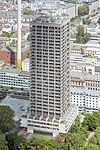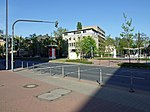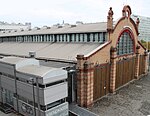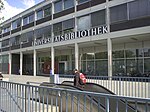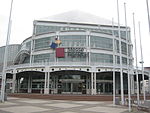Senckenberg Turm
2022 establishments in Germany21st-century architecture in GermanyBuildings and structures completed in 2022Buildings and structures in FrankfurtModernist architecture in Germany ... and 3 more
Office buildings completed in 2022Skyscraper office buildings in FrankfurtSkyscrapers in Frankfurt

The Senckenberg Turm also known as the T-Rex Hybrid High-rise or the 99 West Frankfurt is a high-rise office building in the Westend-Süd district district of Frankfurt, Germany. Built between 2019 and 2022, the tower stands at 106 m (348 ft) with 26 floors and is the current 41st tallest building in Frankfurt. It is also part of the Kulturcampus Complex alongside the One Forty West tower.
Excerpt from the Wikipedia article Senckenberg Turm (License: CC BY-SA 3.0, Authors, Images).Senckenberg Turm
Georg-Voigt-Straße, Frankfurt Westend Süd (Innenstadt 2)
Geographical coordinates (GPS) Address Nearby Places Show on map
Geographical coordinates (GPS)
| Latitude | Longitude |
|---|---|
| N 50.1166 ° | E 8.65054 ° |
Address
Goethe Universität - Campus Bockenheim
Georg-Voigt-Straße
60325 Frankfurt, Westend Süd (Innenstadt 2)
Hesse, Germany
Open on Google Maps
